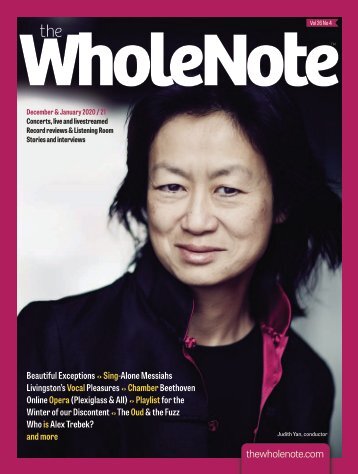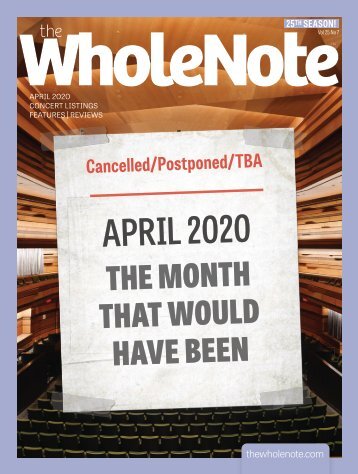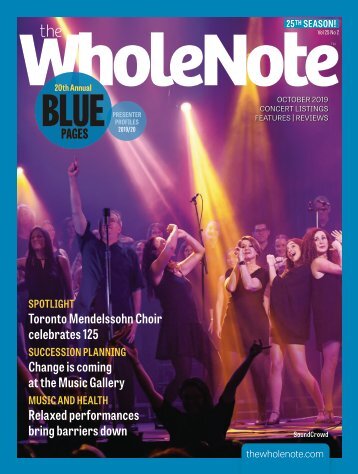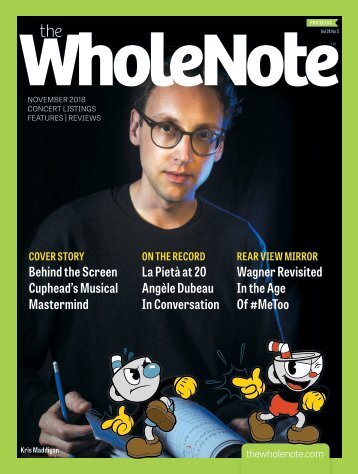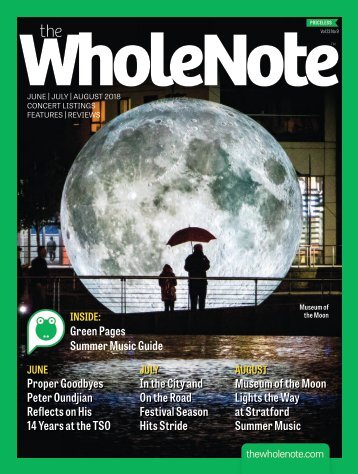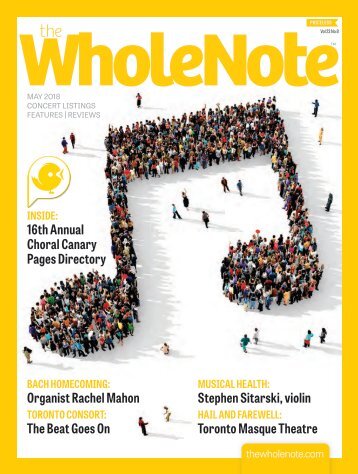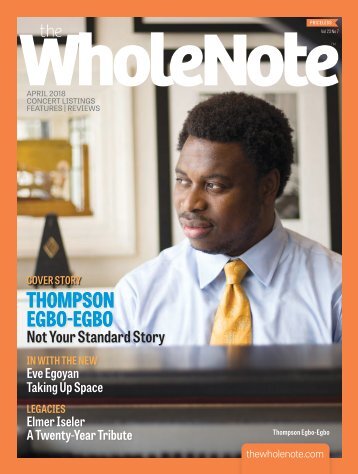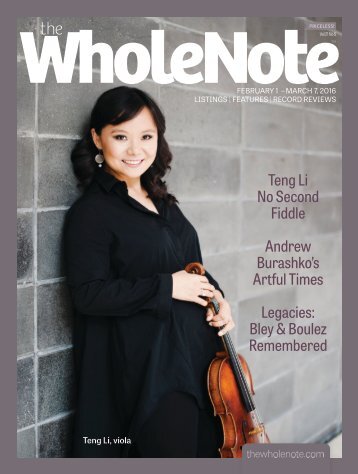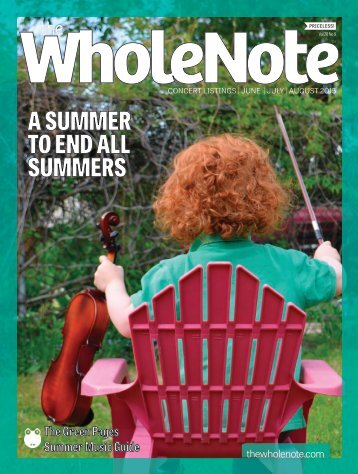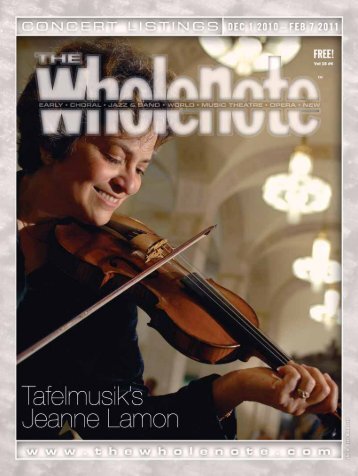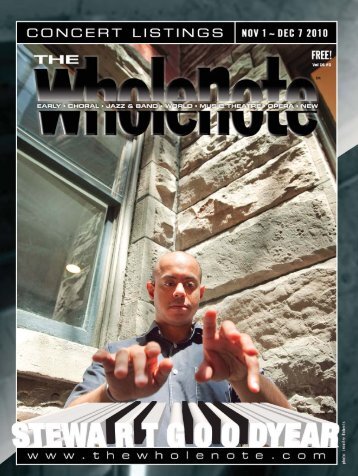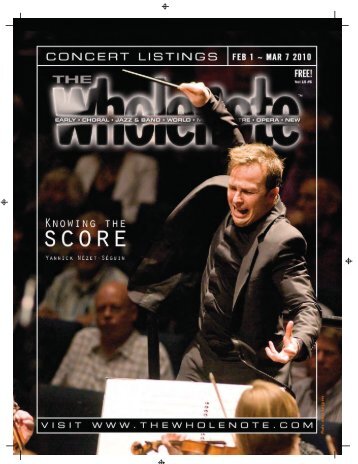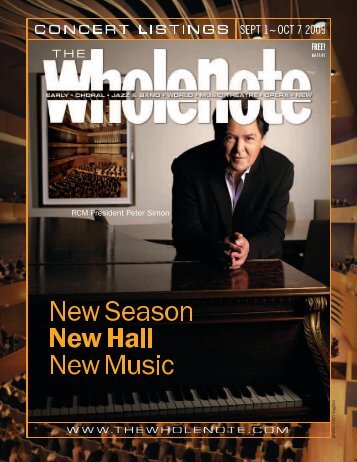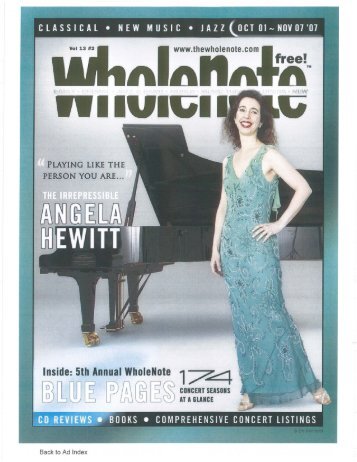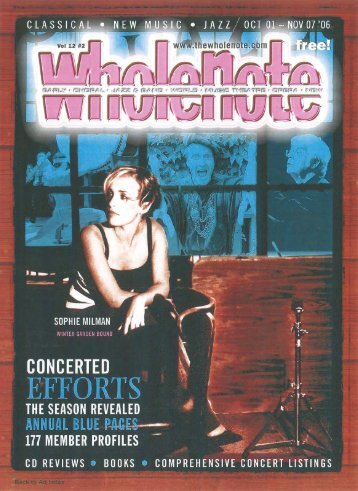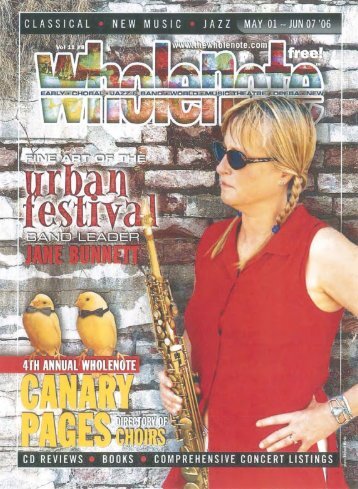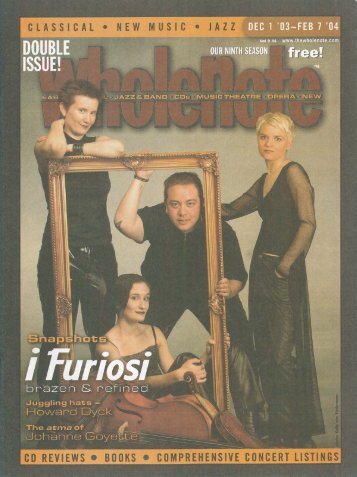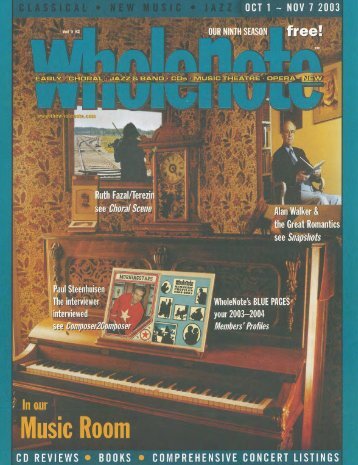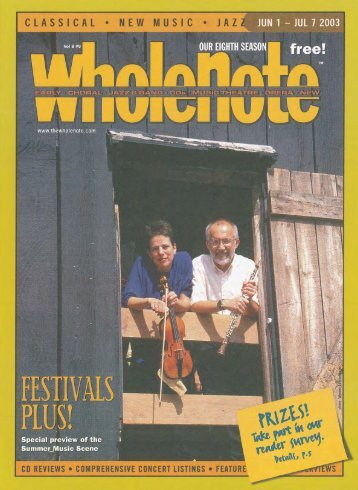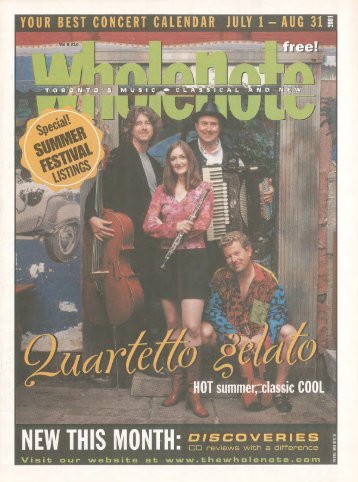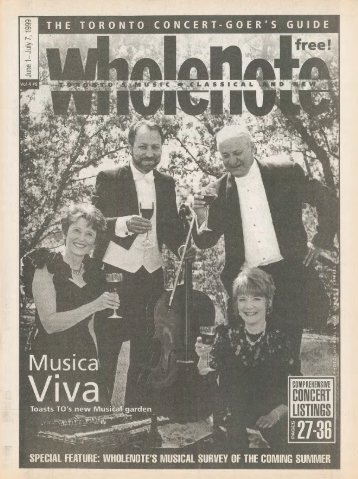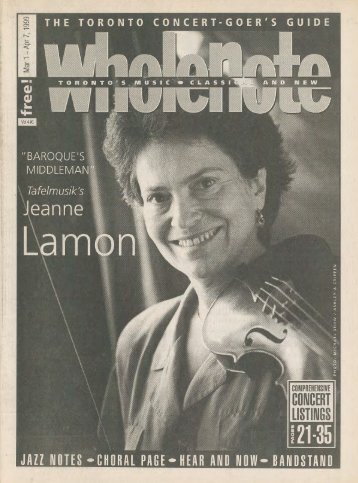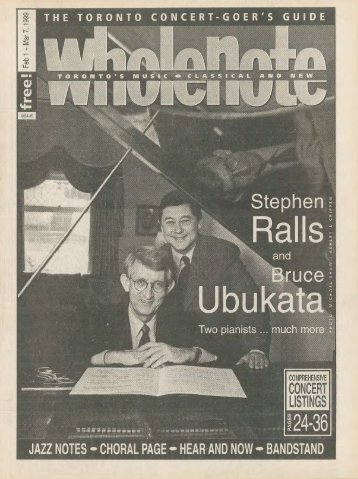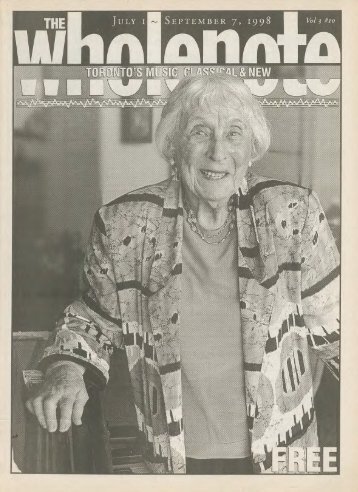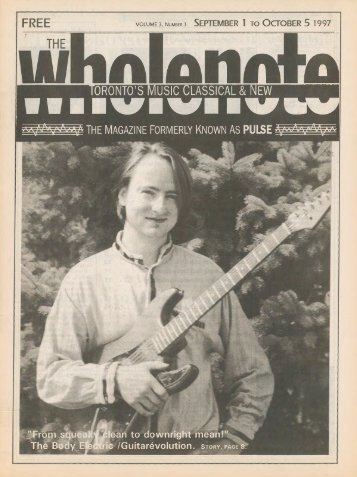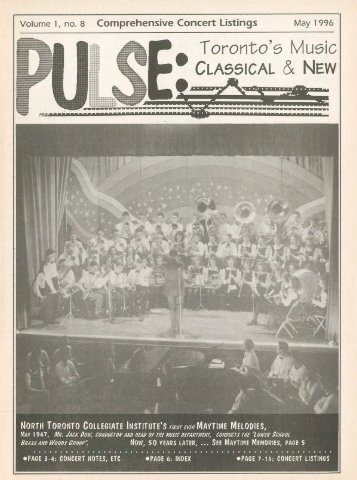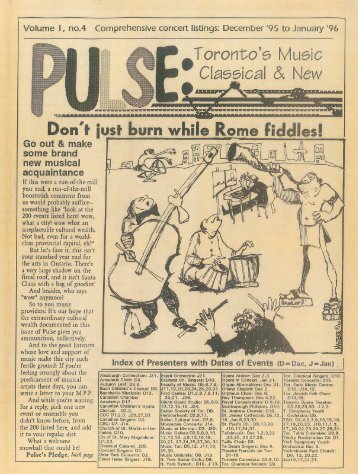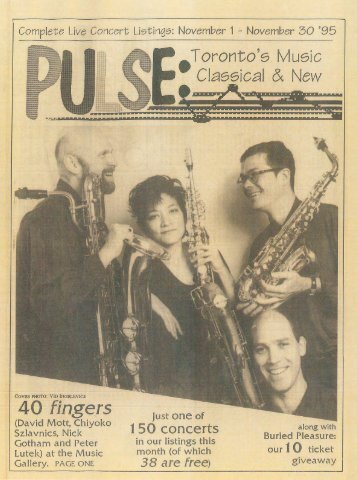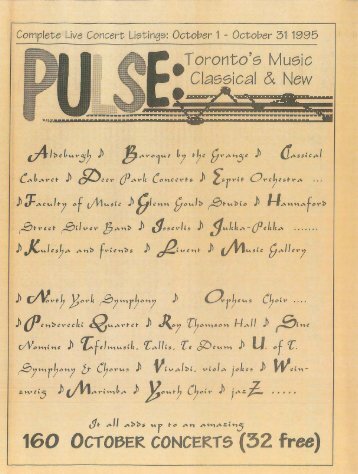Volume 20 Issue 4 - December 2014
- Text
- December
- Toronto
- Jazz
- January
- February
- Symphony
- Arts
- Bloor
- Theatre
- Orchestra
in explorations ranging
in explorations ranging from free improvisationand noise music to traditional blues andfolk, country andwestern and mainstreampop. Guitar inthe Space Age is adirect invocation ofthe music that firstinfluenced Frisell, theworld of electric guitarinstrumentals of thelate 1950s and 1960s, spanning country, rockand its own genre, surf music.Pedal steel guitarist Greg Leisz extendsFrisell’s fondness for bending, reverberanttones, suggesting the period song that’s key tothis project may be one that’s not here: Santo& Johnny’s 1959 hit Sleepwalk. This is a sonicdreamscape, in which melodies like SurferGirl are slowed down and magnified, withsound so rich and dense that Sputnik-eranostalgia (pedal steel virtuoso Speedy West’sReflections from the Moon – almost C&W SunRa in its original form – and The Tornado’sTelstar) assumes cathedral-like dimension.Frisell both reimagines this music andrestores it, along the way touching on thefundamental synthesis of jazz and countryin pieces like Merle Travis’ Cannonball Ragand Jimmy Bryant’s Bryant’s Boogie as wellas invoking the broad sweep of the moralcompass of the times, from the Byrds’ ringingarrangement of Pete Seeger’s EcclesiastesfuelledTurn, Turn, Turn to Link Wray’sjuvenile delinquent anthem Rumble.Stuart BroomerPOT POURRIGreat Wall of ChinaCanadian BrassOpening Day ODR 7433Having listenedto recordings of theCanadian Brass formany years, I was surethat this CD wouldbe in the same styleas previous recordings.Not so. While ithas all of the performancepolish that is the hallmark of this group,there is a big difference. None of the musicis familiar. All 18 tracks are adaptations ofChinese music. First time through I simply satback and listened from beginning to end. In afew words: It is delightfully listenable.Since there are no program notes, I was ata bit of a loss as to where to start to obtaininformation on the selections. Taking thebull by the horns, I called both Howard Cable(who wrote nine of the eighteen adaptations)and Chuck Daellenbach, the founder andtubist of the group. The selections are called“adaptations” because the original materialwas received as recordings on originalChinese instruments which were thenadapted for performance in the brass quintet.As Daellenbach pointed out, just as theday-to-day life in China has evolved due toWestern influence, so has Chinese music.From soft melodies like The Moon RepresentsMy Heart which features the trombone ina jazz style and a very melodic tuba passageto Catching Butterflies While PickingTea with its definite Chinese flavour andamazing ending, or the lullaby-like sensitivityof Colourful Clouds Chasing the Moon,it’s a new musical experience. In particular,Daellenbach’s sensitive melodic tuba is a joyrarely heard. This CD should be added to thelistening material for the classes of instrumentalmusic teachers to show students therange of subtleties and colours achievablewith brass instruments in the right hands.Jack MacQuarriePampa BluesTango BorealATMA ACD2 2706Bandoneonist/composer DenisPlante cunninglyequates the music ofPampa Blues with anaural musical journeyof a horse travellingnorth to south acrossthe Americas. Plante’stongue-in-cheek wit catches one’s attentionwith his opening liner notes sentence“Tango is dead.” Start to listen, and TangoBoreal begins to prove the statement wrong.Plante’s compositions are rooted in the tangotradition with touches of different stylesabounding. His performances with doublebassist Ian Simpson and guitarist DavidJacques gallop into an exciting treat of tightensemble playing, strong writing and heartwarminglyricism.The tracks are grounded in themes.Highlights are the great car-beeping-soundperformance of Ciudad (City), an extractfrom Piazzolla’s Noche de Tango, while twoof Plante’s own stylistically similar excitingworks pay homage to the Argentinian great.In contrast, Plante’s four works dedicated tohis family members are introspective and stirring.The trio plays with sensitivity to nuanceresulting in breathtaking musicality. I lovePlante’s idea of writing the world’s longestphrase for the bandoneon in his TangoRomance. The long phrase with no bellowchange is executed with agility and surprisingtonal control at the end of the line for boththe beautiful melody and the completelyextended bellows!The musicianship is superb. Thetonal expertise of Plante’s bandoneonis unmatched. Simpson drives the bassrhythm with colour and bounce. Jacques isequally great in both guitar lead melody andsupporting roles. Together they are keepingmore than just tango alive!Tiina KiikDelicate Paths – Music for ShōSarah Peebles; with Evan Parker, NilanPerera, Suba Sankaranunsounds 42U (unsounds.com)For some quarter century the TorontobasedAmerican composer, improviser andinstallation artistSarah Peebles hasconducted a musicallove affair with theshō, the Japanesemouth organ. Eversince studying itsfoundational repertoireembedded in themusic of the antique gagaku, performed bythe orchestra of the Japanese court, she hassought to explore the shō’s sonic strengths.She has particularly identified with its abilityto produce microtonal and psychoacousticeffects reifying sound, often unfoldingleisurely over time.There is yet another key element on thisalbum. Bees. Peebles’ installation art practiceexplores the lives of wild bees, pollinationecology and biodiversity, a branch ofBioArt. This concern not only explains someof the titles of the works here – i.e. ResinousFold – but it is also reflected in the synergisticrelationships between mouth organs and theresinous production of bees. Tropical stinglessbees secrete a resin which has been gatheredfrom wild nests for millennia and appliedto many human artifacts, including mouthorgans. The shō is no exception. You can viewa number of fascinating photos, of both beehabitats and the delicate shō reeds for whichtheir products are an essential ingredient, onthe web page for Delicate Paths hosted by the“unsounds” label.Peebles’ music employs both improvisationand composition, embracing acousticas well as digitally processed performance.While shō is clearly featured, the albuminvites other musicians into the musicmaking. On Delicate Paths she has includedthree star improvisers: a familiar reed instrument,a string, and a voice. Free jazz-rootedsaxophonist Evan Parker, prepared electricguitarist Nilan Perera and multi-genre vocalistSuba Sankaran join Peebles. They are cannychoices. Each effectively supports, contestsand offsets her shō’s melodic long tones andclusters, providing welcome musical tensions,cultural reframings, as well as textural andtimbral richness.Slipping the CD out of its handsome blacktrifold case I was delighted by its striking,subtly translucent honey-coloured appearance.Repeated listening revealed music ofrefinement, occasionally graced with a gentleaural sweetness, which in my imagination atleast, resonates with a key component of theshō’s inner workings.Andrew Timar82 | December 1 2014 - February 7, 2015 thewholenote.com
There’s evidently sufficient saxophonetalent in Canada now that we export it withsome regularity. Three émigré reed playershave recently released CDs of interest.Toronto-bornAndrew Rathbun hasspent the past decadeplaying and studyingin New York City,recently joining theJazz Studies departmentat WesternMichigan University.On Numbers & Letters (Steeplechase SCCD31781 steeplechase.dk), Rathbun is an adroitstylist on tenor and soprano, composingmemorably playful lines (the compositionshere are inspired by his two young children)and developing them with fleet, sometimesabstracted, sometimes effervescentlines. The interval leaps of Etude can suggestthe influence of the late Kenny Wheeler withwhom Rathbun has recorded, and there isa similar lyricism and facility in developingcomplex, ambiguous moods. Rathbun hasput together a superb band for the recording,building upward from the mobile, shiftingdrumming of Bill Stewart and the bass of JayAnderson to virtuosic pianist Phil Markowitz,the three creating ongoing stimulation forRathbun’s forays.Anna Webber isa young composer,flutist and saxophonistwho has alreadybecome a presencein forward-lookingcircles in Brooklynand Berlin. Her latestrecording, Simple (Skirl 027 skirlrecords.com), was composed during solitary dayson Bowen Island off the coast of her nativeBritish Columbia. While the music soundsinspired, you’ll listen in vain for mimetic seasounds and easy tranquility: Webber’s musicis complex, angular and sometimes downrightspiky; her inspirations funneled throughher own edgy sensibility and the creativeprocesses of her playing partners here,pianist Matt Mitchell and percussionist JohnHollenbeck. The results are episodic piecesthat are never less than structurally soundand loaded with sudden turns, whethercomposed or improvised. Webber’s tenorSTUART BROOMERsaxophone twists withcompound emotionthrough the taut 1994,while her flute weavesthrough Simplify,Simplify with scintillatingprecision.SaxophonistPeter Van Huffel has followed a similarpath from Kingston, Ontario to New Yorkand on to Berlin. On Bite My Blues (CleanFeed CF302CD cleanfeed-records.com), heleads his Berlin-based band Gorilla Maskin performances at Toronto venues EmmettRay and Tranzac, recorded during a 2013Canadian tour. While Van Huffel often worksin chamber-like textures, Gorilla Mask is avisceral band driven by pounding, industrialpolyrhythms and electronics providedby Roland Fidezius on electric bass andeffects and Rudi Fischerlehner on drums. VanHuffel uses the dense undergrowth and histruncated, machine-gun themes to propelfurious alto saxophone improvisations, spirallingacross registerswith blistering intensity,creating varied,complex lines. Withinthis assault, somefascinating changes ofpace that reveal VanHuffel’s specific roots:on the lyrical Broken Flower, his keeningsaxophone wail invokes Albert Ayler’s balladperformances, while Fast and Furious showsroots in Ornette Coleman.That saxophone emphasis continueswith two new releases on Toronto’s AddoRecords. Alto and soprano saxophonist TaraDavidson’s Duets (AJR026 addorecords.com) explores what may be the most challengingof improvising formats with six differentcollaborators. There are two pieces with eachpartner, one a Davidson composition, theother her collaborator’s. Davidson combinesforethought with an ability to work keenlyin the moment. What’s surprising is both thevariety of approaches and the sustained creativity.Interests in unusual modes link cellist/bassist Andrew Downing’s Kontrbas Semaisito pianist David Braid’s two-part Lele’s Tune,while Davidson’s duets with tenor saxophonistsMike Murley (her first saxophoneteacher) and Trevor Hogg possess subtleties ofharmony, timbre and line that suggest affinitieswith the fertile saxophone partnershipof Lee Konitz and Warne Marsh. Turningfrom her usual alto, Davidson’s most lyricalmoments come on soprano saxophone,including the exchange of glassy, wispysounds with guitarist David Occhipinti on hisSilver Skates and the melodic effusion of ForGlenda with pianist Laila Biali.Eli Bennettis a 25-year-oldVancouver-raisedtenor saxophonistwho has been pilingup awards for severalyears while attendingToronto’s HumberCollege jazz program. He arrives with theendorsement of numerous senior saxophonists,including Chris Potter, Cory Weedsand the producer of his debut CD, KirkMacDonald. The enthusiasm is understandablegiven the general level of Breakthrough(Addo Records AJR024). His key influenceis apparently John Coltrane, evident in thebeautiful metallic tone and gauzy highs of thereflective Forever as well as a run-throughof Coltrane’s Giant Steps. It’s tempered byBennett’s enthusiasm for R&B-flavouredsoul jazz, bringing a quotient of funky licksand sonic grit to originals like Let’s Roll andthe highlight of the CD, the majestic andearthy title track, where all of his virtuescome together. He’s ably accompanied by anexcellent Toronto rhythm section of D’ArcyMyronuk on piano and Fender Rhodes, bassistJon Maharaj and drummer Fabio Ragnelli.Carol McCartney has been a vocalist toseek out since her2007 debut A Nightin Tunisia, declaringwith its title a devotionto jazz moredemanding thanmany singers will risk,stretching from standardsand ballads to the demands of bop. Thebreadth of her repertoire and the quality ofher soaring alto voice are evident on her latestCD, Be Cool (Moxy 014, carolmccartney.com)where she stretches from the Joni Mitchellcomposedtitle track to Duke Ellington’sTulip or Turnip and Wes Montgomery’s WestCoast Blues. She’s joined by stellar musicians,including guitarist Lorne Lofsky,drummer Terry Clarke, bassist Kieran Oversand tenor saxophonist Chris Robinson, withpianist Brian Dickinson and Rick Wilkinsproviding arrangements. McCartney’s scattingon Almost Twelve makes the bossa novaa standout.There’s always more music to DISCover online at thewholenote.comthewholenote.com December 1 2014 - February 7, 2015 | 83
- Page 1 and 2:
PRICELESS!Vol 20 No 4CONCERT LISTIN
- Page 3 and 4:
JOIN US INTHE NEW YEARFOR THISBLOCK
- Page 5 and 6:
Volume 20 No 4 | December 1, 2014 t
- Page 7 and 8:
If this were your concert, on the o
- Page 9 and 10:
summer before she launched out on a
- Page 11 and 12:
KOERNER HALL IS:“A beautiful spac
- Page 13 and 14:
PresentsSPLENDºURS oƒ~E EMPE|o R
- Page 15 and 16:
listening to the Holly Cole Trio an
- Page 17 and 18:
Aurora Cultural Centre presents2015
- Page 19 and 20:
Grammophon CDs.“In Mozart you’r
- Page 21 and 22:
Beat by Beat | In With the NewSound
- Page 23 and 24:
Beat by Beat | World ViewAutoricksh
- Page 25 and 26:
Beat by Beat | Choral SceneA Non-Sh
- Page 27 and 28:
fable, Brother Heinrich’s Christm
- Page 29 and 30:
Beat by Beat | Early MusicFirst Rat
- Page 31 and 32: the media. By comparison in 2012/13
- Page 33 and 34: Beat by Beat | BandstandA Night toR
- Page 35 and 36: marvellously new, some precisely be
- Page 37 and 38: Ott, piano; Cristian Măcelaru, con
- Page 39 and 40: (sr); (st).● ● 7:30: Vill
- Page 41 and 42: ● ● 1:00: Cathedral Church of S
- Page 43 and 44: Dec 12 7:30; Also 7:30.● ● 3:00
- Page 45 and 46: Carols byCandlelightSun., Dec. 14,
- Page 47 and 48: 416-532-3019. or PWYC. Signup 7
- Page 49 and 50: an Ontario government agencyun orga
- Page 51 and 52: Krosnick, cello; Roger Tapping, vio
- Page 53 and 54: kleine Nichtmusik. Matthew Halls, c
- Page 55 and 56: .● ● 7:30: University of Tor
- Page 57 and 58: Music. New Music Festival: Presenta
- Page 59 and 60: Centre for the Arts, Brock Universi
- Page 61 and 62: B. Concerts Beyond the GTAcomposer
- Page 63 and 64: Taste of Motown with The Barrymores
- Page 65 and 66: and his Trio ; 7pm Sam Broverman
- Page 67 and 68: an Ontario government agencyun orga
- Page 69 and 70: Classified Advertising | classad@th
- Page 71 and 72: LEIGH MILLERWE ARE ALL MUSIC’S CH
- Page 73 and 74: instance this is not the case and w
- Page 75 and 76: their legacy. After all, Maria Call
- Page 77 and 78: music, infusing it with youthful vi
- Page 79 and 80: a setting of a poem by Robert Servi
- Page 81: Pete Magadini, had just begun his 2
- Page 85 and 86: DEC 13 8PMMASSEY HALLDEC 17 8PMHARB
- Page 88: SEASON PRESENTING SPONSORHALLELUJAH
Inappropriate
Loading...
Mail this publication
Loading...
Embed
Loading...
























